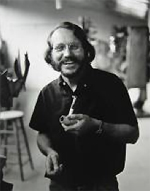Born in Spain in 1925, Izquierdo spent his early years in Madrid. In 1939 Izquierdo escaped the chaotic aftermath of the Spanish Civil War with his brother and sister. While at a sanctuary for children in France, Izquierdo's talents were recognized and he was enrolled in classes at the École des Beaux Arts in Marseilles.
In 1941, the Nazis were closing in on France and it became apparent that the family would need to flee again. The “One Thousand Children” act by Congress allowed children to be evacuated to the United States but stipulated that the children must be 14 or younger. To prevent being separated, Izquierdo's documents were altered to state that he was 13 (instead of 17) and they departed France in May of 1942.
Refusing to be separated in the United States, Izquierdo waited until 1943 when a Portland family was able to take all three of them in. Once in Portland, Izquierdo met several key artists. Lloyd Reynolds became an important mentor and counselor for the teenager and introduced Izquierdo to block printing, while Frederic Littman became Izquierdo’s primary sculpture instructor and mentor throughout the 1940s. Izquierdo enrolled at the Museum Art School (now the Pacific Northwest College of Art). With Reynolds’ encouragement, he applied for and received a scholarship. In time, Izquierdo would join the faculty at the Museum Art School where he influenced several generations of students and emerged as a dynamic force in the Oregon art scene.
“He was destined to become a key figure in Oregon’s golden age of modern sculpture,” says Hull. “He pioneered welded metal sculpture in the Pacific Northwest and became best known for his steel and bronze works that are marvels of adventurous form-making and stunning technical proficiency. He took pride in being a highly regarded member of the august group of Oregon modern sculptors that included Hilda Morris and Frederic Littman as well as Tom Hardy, James Lee Hansen, Lee Kelly, and Jan Zach.”
More on the life of Manuel Izquierdo at Oregon Encyclopedia

